Dumpling sauce is a crucial element that elevates the flavors of jiaozi, potstickers, wontons, and all other types of dumplings. I have two easy dumpling sauce recipes to share with you today- one is a Chinese dumpling sauce full of scallions and fresh garlic, with some heat and nuttiness. And a classic Japanese dumpling sauce full of umami and sour flavors that I always serve with gyoza.
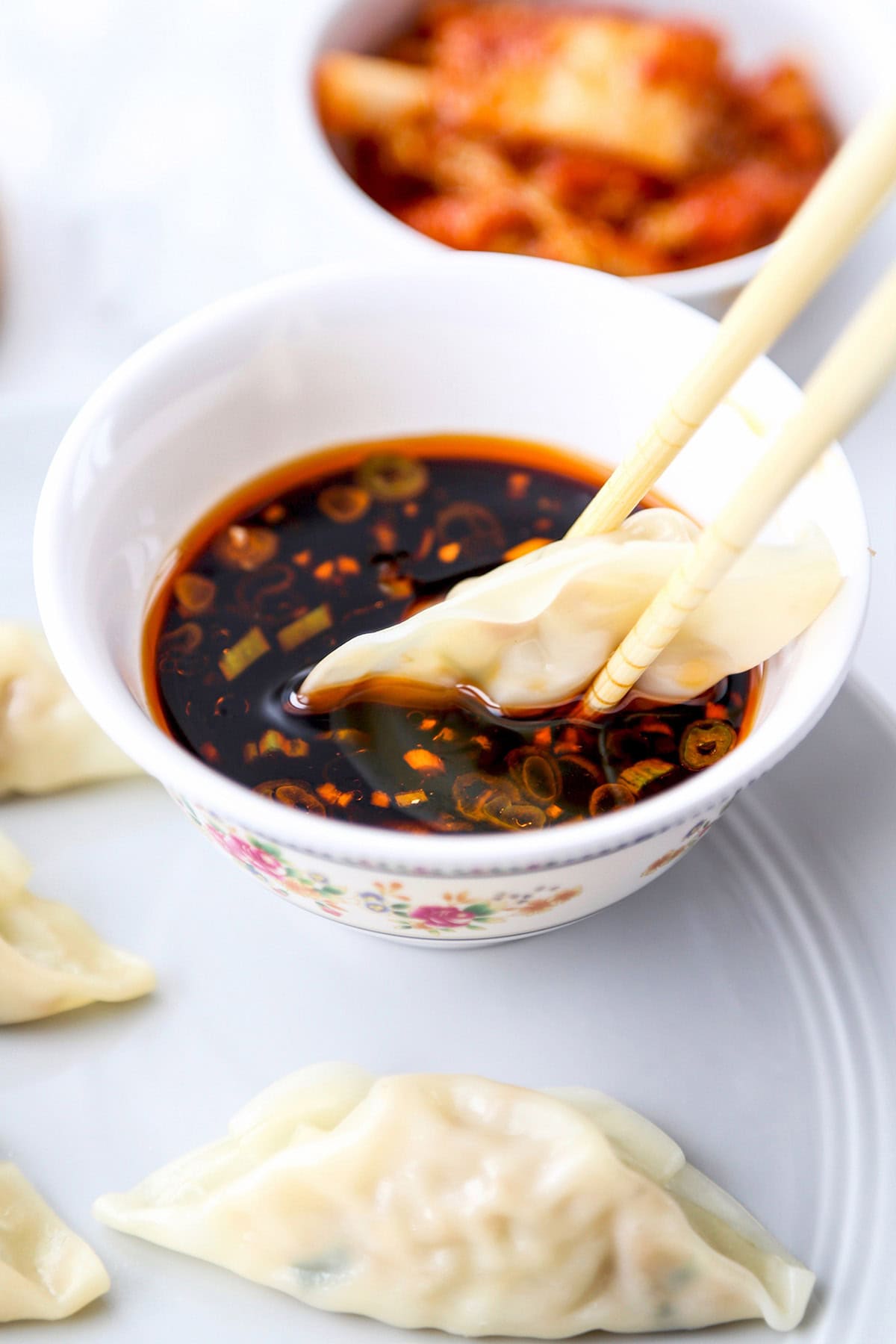
For me, no trip to the ramen shop is complete without a side of gyoza and a punchy dumpling sauce on the side. Same goes with a mid-day voyage to Manhattan’s Chinatown for dim sum from the pushcarts. I could devour fried wontons, steamed har gao, and bao buns by the truckload.
Like these mushroom cabbage dumplings and avocado and cheese dumplings, potstickers come in many delicious forms. However, the variety of dipping sauces offered doesn’t get the spotlight it deserves. But did you know you can make a proper dumpling sauce in 5 minutes with a handful of simple pantry ingredients that will rival the ones from your favorite restaurants? In this post I’m going to show you how to make dumpling sauce with a handful of ingredients and in just a few minutes.
Table of contents
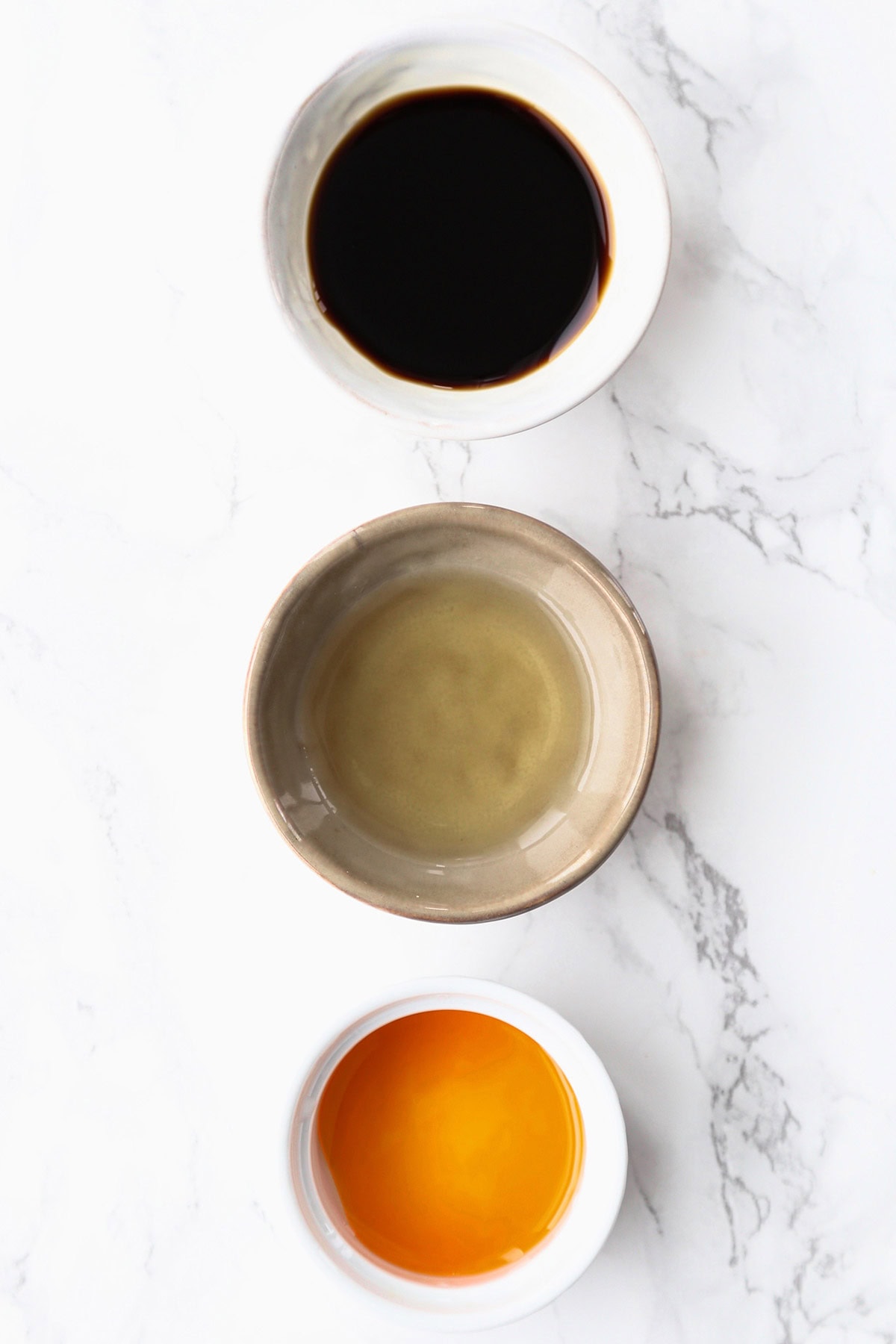
Dumpling Sauce Ingredients
Chinese Dumpling Sauce
- Garlic: A single minced garlic clove is enough to infuse the sauce with a pungent and slightly spicy undertone that marries beautifully with the other ingredients.
- Green onions: Green onions add a refreshing crunch and touch of sweetness. They also help to balance out the flavors of the other ingredients.
- Soy Sauce: Regular soy sauce is the main savory component of these two dipping sauces. With a complex set of flavors ranging from salty to earthy to almost imperceptibly sweet, soy sauce is an absolute must for this recipe.
- Chinkiang Vinegar: Chinkiang vinegar is a Chinese black vinegar with fruity and tangy flavors. Typically served in a ramekin with thin strips of ginger alongside dim sum favorites like xiao long bao, this is an iconic ingredient worth getting your hands on.
- Chili Oil: I like to use a chili oil that is sesame based. That way I get a one-two punch of toasted nutty perfection with a bit of fire. Chili oil can be quite spicy so if you are sensitive to spicy foods, add a little at a time, until you find the right amount of heat.
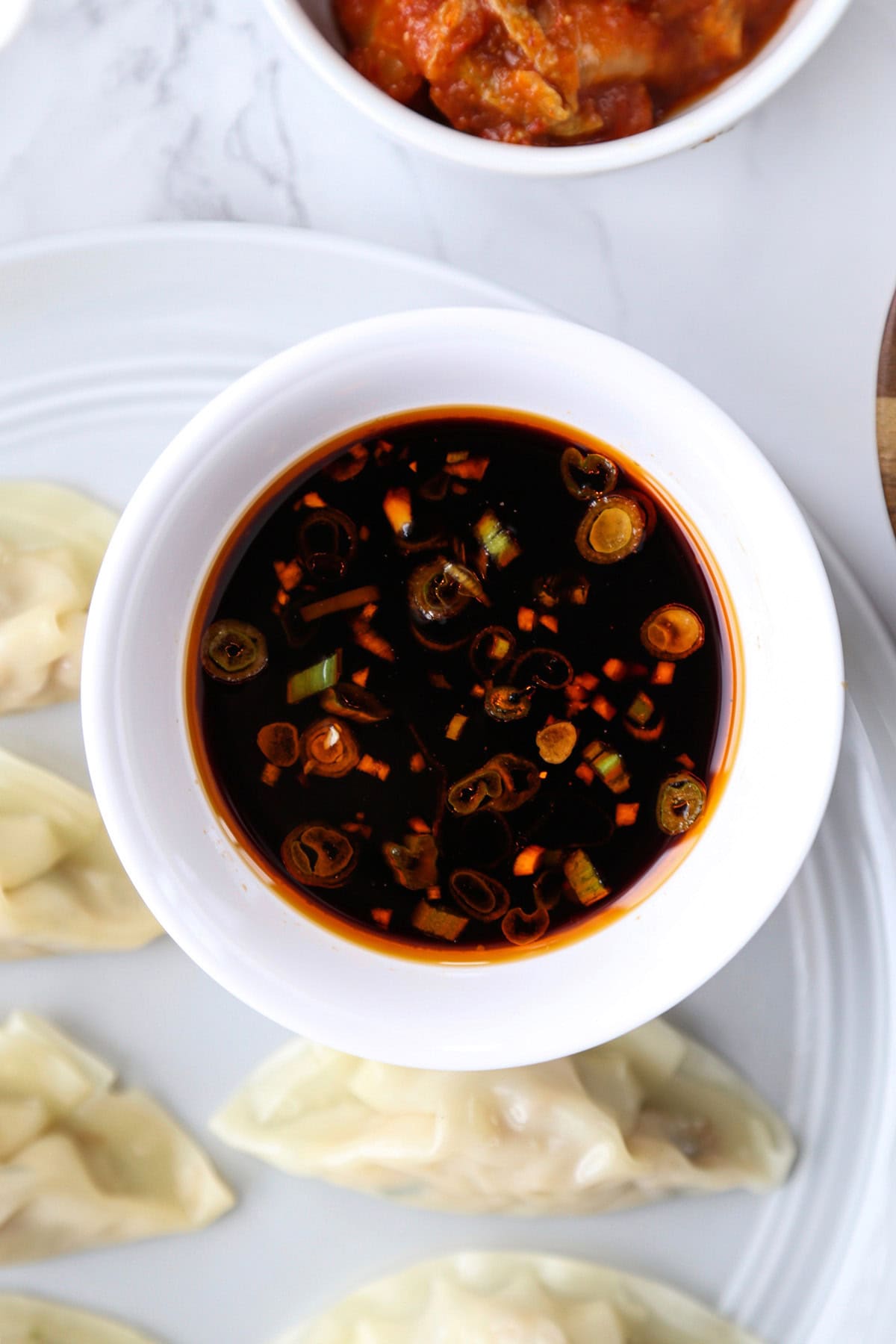
Japanese Dumpling Sauce
- Soy Sauce: I always use regular Japanese soy sauce for this recipe. That’s because Japanese soy sauce has more depth of flavor than other types of soy sauces, and is generally more rounded.
- Rice Vinegar: Rice vinegar is less harsh than other types of vinegar. It’s fruity, tangy, and a little sweet, almost like apple cider vinegar. Typically used in sushi rice, salad dressings and for pickling – this is one ingredient I keep in my pantry for many Asian recipes.
- Chili Oil: A teaspoon of chili oil is all you’ll need to round out the flavor with a slight pop of spice. Your gyoza are going to taste amazing! You can buy it at the store, or make your own chili oil.
Ingredient Substitutions
If you don’t have all of the ingredients on hand or would like to alter the flavor to suit your taste, here are a few substitutions I recommend you try.
- Instead of chinkiang vinegar, use two parts balsamic vinegar with one part soy sauce. Balsamic brings a thick and sweet fruitiness that’s specific to chinkiang vinegar.
- For Japanese dumpling sauce, swap rice vinegar for apple cider vinegar. They both have a slight sweet and fruity element.
- Use toasted sesame oil instead of chili oil for a non spicy dumpling sauce. I recommend adding a little extra sesame oil to make it more nutty.
- Use low-sodium soy sauce for less salty. This is for those who are watching their sodiu intake.
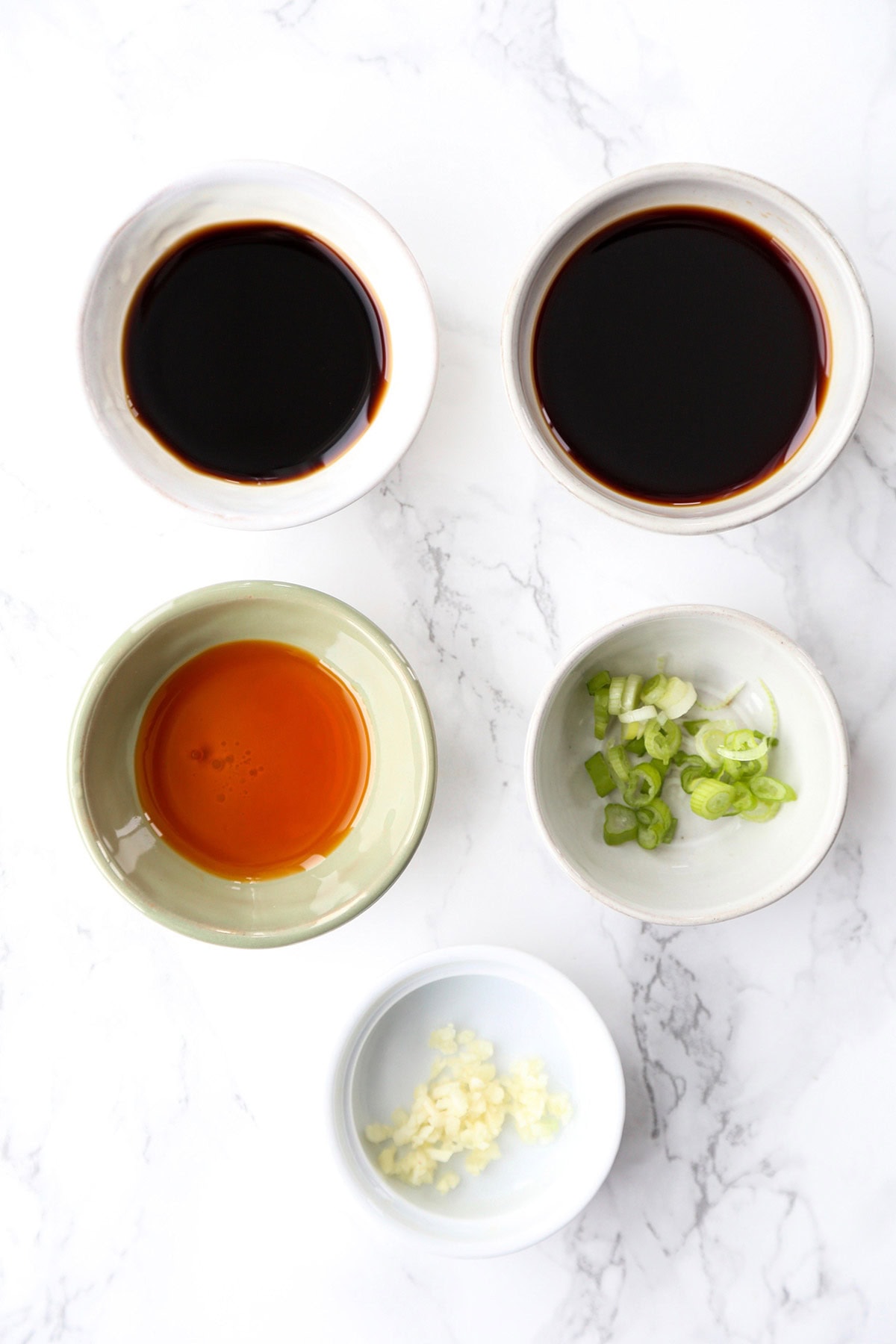
How To Make Dumpling Sauce
Scroll all the way down to the recipe card for the full recipe.
- To make the Chinese dumpling sauce, start by peeling and mincing the garlic. then, add the garlic to a bowl along with the chopped green onions, soy sauce, chinkiang vinegar, and chili oil. Stir and serve.
- To make the Japanese dumpling sauce, whisk the soy sauce, rice vinegar, and chili oil in a small bowl.
- Serve them with your favorite dumplings, pot stickers, spring rolls, or egg rolls, and enjoy!
Double Or Triple The Recipe
Make extra so it’s ready to use next time you need it! That’s something I always do when I make one of these recipes. If you are like me and enjoy eating dumplings on a regular basis, I suggest that you double the recipe and keep the extra in your fridge.
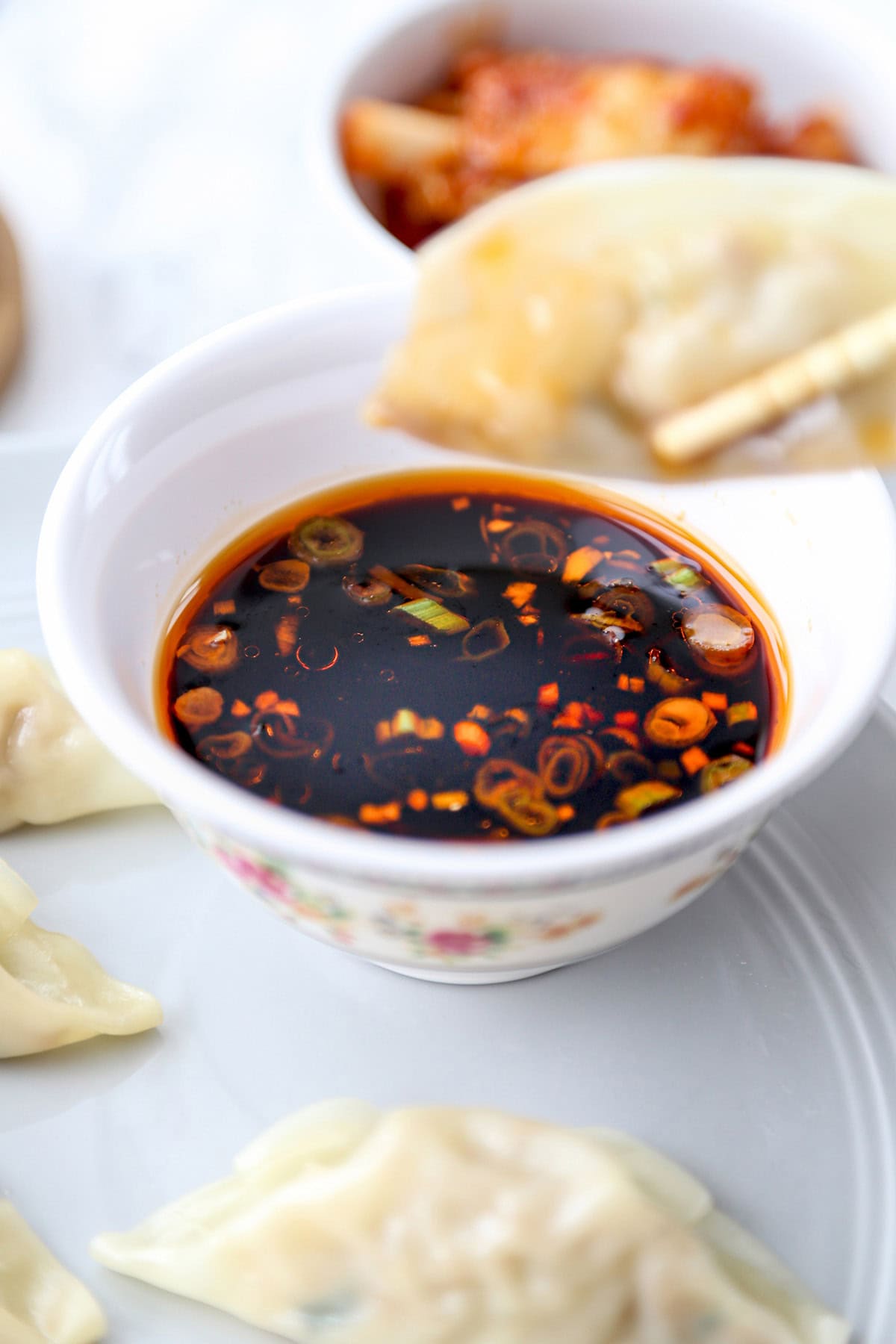
More Ways To Use These Dumpling Sauces
Other than dumplings, these sauces can be used to dip spring rolls, egg rolls, and bao buns. They can also be used as a sauce to drizzle on chilled noodles and silken tofu, and as a marinade to shrimp, chicken, beef, and other proteins. The options are endless!
Storage
- Japanese dumpling sauce: Store it in a jar or other storage container and refrigerate for up to 6 weeks.
- Chinese dumpling sauce: Store it in a jar or other storage container and refrigerate for up to 2 weeks. This sauce doesn’t keep as long as the other one because it contains fresh ingredients like scallions and garlic.
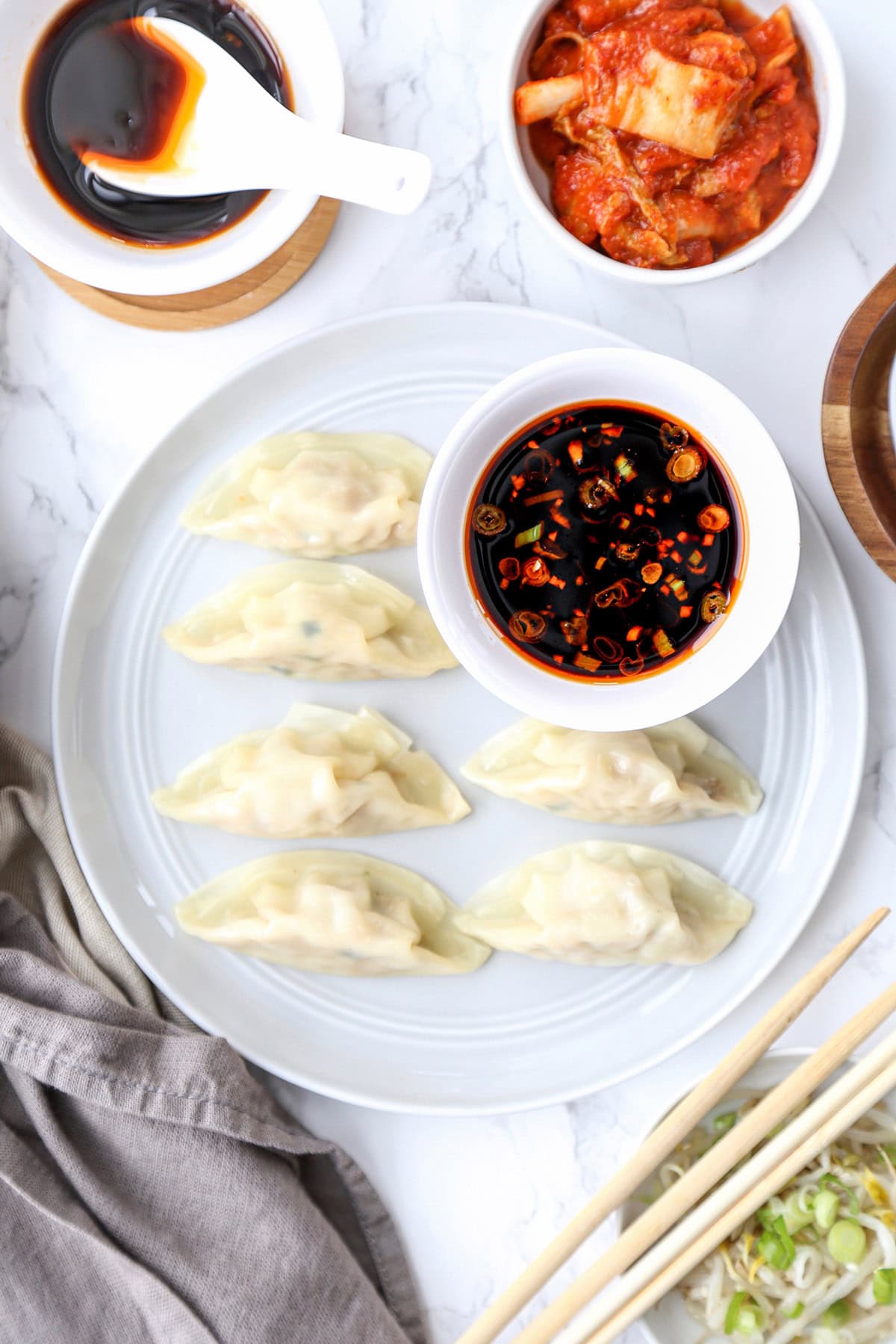
Frequently Asked Questions
Flavor wise, it depends on the type of sauce purchased. The biggest difference between homemade and store bought dumpling sauce is that the homemade version doesn’t contain sugar, additives, or processed ingredients. Also, with homemade sauce, it can be adjusted to match your palate to a tee!
Use tamari or liquid aminos instead of soy sauce. All the other ingredients are naturally gluten-free.
You can add a little honey or brown sugar. Or you can also can a little peanut butter to make the sauce sweet and creamy.
What To Serve With It
There are so many dishes to serve with dumplings that it would take me an entire post to list them! I feel like they go so well with everything from soups, to noodles, rice dishes, and stir fries. Here are some of my favorites:
- Miso Ramen (ミソ ラーメン)
- Chinese Eggplant With Garlic Sauce
- Egg Fried Rice
- Japanese curry rice
- Dan dan noodles
- Nasu dengaku
Other homemade sauces you might like to try: Teriyaki sauce, eel sauce, bibimbap sauce, tonkatsu sauce, hoisin sauce, stir fry sauce, black bean sauce.
Have you made this recipe? Are there changes you made that you would like to share? Share your tips and recommendations in the comments section below!
Print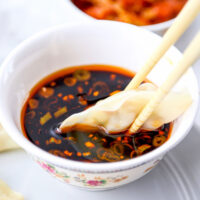
Classic Dumpling Sauce
- Prep Time: 5 minutes
- Cook Time: 0 minutes
- Total Time: 5 minutes
- Yield: 6 tablespoons 1x
- Category: Condiment
- Method: Stirring
- Cuisine: Chinese
- Diet: Vegan
Description
Two easy and delicious dumpling sauce recipes. One is a Japanese version while the other one is a take on Chinese dumpling sauce.
Ingredients
Dumpling Sauce
Chinese dumpling sauce
- 1 garlic clove, minced
- 1 scallion, finely chopped
- 3 tablespoons soy sauce
- 2 tablespoons chinkiang vinegar
- 1 tablespoon chili oil
Japanese dumpling sauce
- 3 tablespoon soy sauce
- 1 tablespoon plain rice vinegar
- 1 teaspoon chili oil
Instructions
Notes
Storage: Transfer each sauce to an airtight storage container. The Chinese dumpling sauce will keep for up to 2 weeks, refrigerated. The Japanese sauce will keep for up to 6 weeks, refrigerated, because it doesn’t contain any fresh ingredients.
Variations: Use toasted sesame oil instead of chili oil if you don’t like spicy foods. Add 1 teaspoon honey to the Chinese dumpling sauce to add sweetness. Add a little yuzu kosho to the Japanese dumpling sauce to add a citrus note and some heat.
Gluten-free: Instead of soy sauce, use tamari or liquid aminos.
Nutrition
- Serving Size: 2 tablespoons
- Calories: 57
- Sugar: 0.9g
- Sodium: 434.8mg
- Fat: 4.6g
- Saturated Fat: 0.6g
- Unsaturated Fat: 1.9g
- Trans Fat: 0g
- Carbohydrates: 2.6g
- Fiber: 0.1g
- Protein: 1.3g
- Cholesterol: 0mg
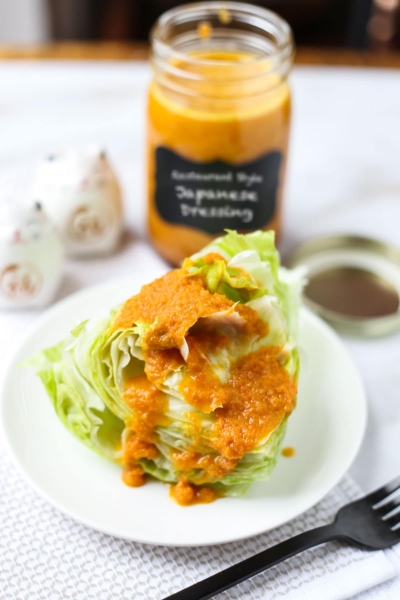

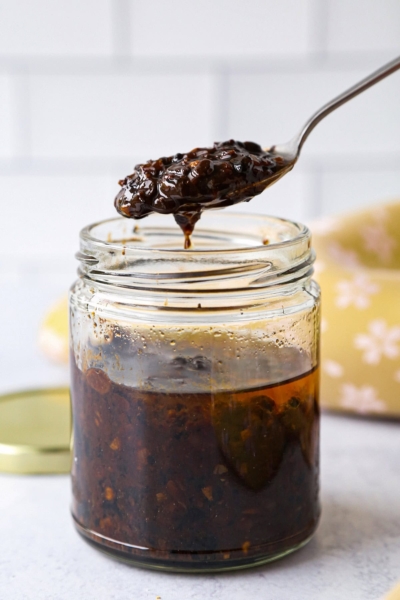
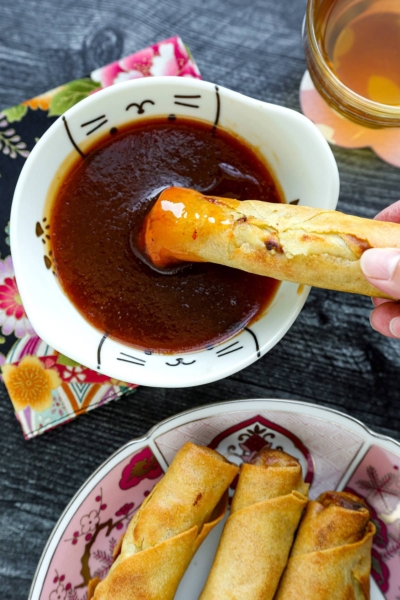















Questions and Reviews
This really is the best dumpling sauce recipe that I have found. I make sure to always have this on hand in our refrigerator.
Thank you Leahnna!
Loved it! I used Mirin since I didn’t have the chinkiang vinegar and it was delish!!
Thank you Jenn! 🙂
Very easy to make and tastes amazing!!
I made these before I had Black Vinegar and they were marvelous. By far the best i’ve had. Then I got some Black Vinegar and Chili Crisp from Fly by Jing and now the Chinese one is out of this world. There is a link for the vinegar earlier in the page. I urge you to buy it.
I love all your sauces and share the links with my cousins who love ‘my’ recipes/cooking! These recipes are looking delicious and I can’t wait to incorporate them into our rotation. I currently use a dipping sauce made from balsamic vinegar and red rooster chili garlic sauce. Sometimes a splash of soy sauce or sesame oil to mix it up (but the sesame oil floats on top and I don’t get the tang from below).
Loved it! Didn’t have the chilli oil so substituted sesame oil and pepper flakes, extra garlic because hey we’re Italian lol, added some honey and grated ginger because hubby loves it. Thank you, thank you, thank you!
I made the Chinese Dumplin Sauce tonight for some Mini Wontons and my family (and I) couldn’t get enough of it! So much better than any other I have tried. We did increase the fire oil just a bit since we enjoy a little more heat, so delicious! Thanks for sharing this recipe!
This is perfect – I tried the Chinese dumpling sauce and we loved it. Thanks for sharing!
Thank you Courtney! 🙂
Have been looking for a good sauce for several years. This was perfect! Tasted as good, if not better then what I’ve had in real Chinese restaurants. You know, the ones that serve the Asia people in the area. Thanks for sharing this recipe.
Thank you Dale! 🙂
Made both, they tasted very similar but both yummy!
Question – If I make too much of the dipping sauce, how long is it good for if kept in the refrigerator?
Hi Jenny! The sauce will keep for about 4 weeks, refrigerated 🙂
Looking forward to trying this recipe, and learning new ones, with the pandemic all around us, I am embracing cooking at home.
That’s wonderful Clayton, and welcome to Pickled Plum! 🙂
Hi, Just came across this recipe and wanted to know exactly what type of soy sauce should you use for the dumpling sauce? Light, dark, and thick soy sauce?
Hi Daniela! I use regular soy sauce but you light also works 🙂
Hi Daniela, I am assuming that Caroline was referring to the choice that most Western white people have, which is “regular” or reduced sodium. I interpret your question to be light soy sauce vs dark soy sauce, and for my version of this type of sauce I would use light because dark would be too strong for me, but that’s largely my preference.
I had frozen dumplings on hand and wanted a light supper. No dipping sauce . So going by my memory of dumpling sauce from my fav Chinese restaurants… I got creative. I made sweet and sour vinegar (equal parts apple cider vinegar, water, and brown sugar…Heated until sugar is dissolved in micro. ) Next came the soy sauce… I used the same amount of it… as I had used making the sweet and sour vinegar… 1/2 c soy, 1/2 cup sugar, 1/2 c water, and 1/2 cup vinegar. Mixed the ingredients together. Added one clove of minced garlic , and a sprinkle of Asian ginger/pepper spice I always have on hand! Wonderful result!
These sauces look delicious!
I came across this post at work today, because I was looking for a dumpling recipe I could make in batches and bring to work and store in my locker. I’m a 911 Dispatcher, and can’t leave for meals during my shift. My locker has turned into a bit of a condiment storage place (my co-workers affectionately laugh at me, but I’m the first person they come to if they need soy sauce!). I had some frozen soup dumplings that didn’t have a sauce included, and I wanted something with umami and acid. I had some oyster sauce and some ponzu in my locker, so I combined those two until the flavors were balanced, and then added a bit of sesame oil. While not a traditional dumpling sauce, it was delicious and I will definitely be combining these flavors to add to some of my dishes at home! I see sautéed spinach with this combination in my future!
I love your story Dani (I laughed out loud about your locker turning into a condiment storage place!), thank you for sharing 🙂